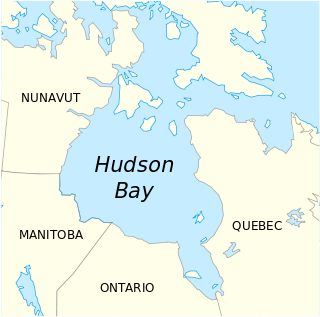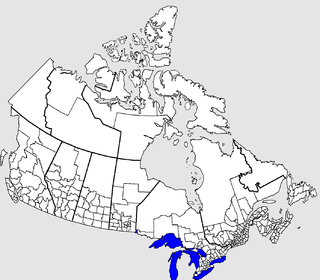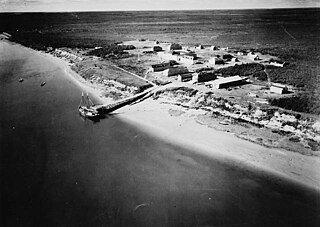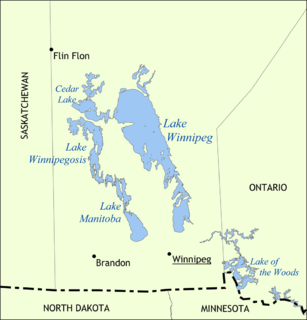
Lake Winnipeg is a very large, but relatively shallow 24,514-square-kilometre (9,465 sq mi) lake in North America, in the province of Manitoba, Canada. Its southern end is about 55 kilometres (34 mi) north of the city of Winnipeg. It is the largest lake within southern Canada's borders, and is part of the most undeveloped large watershed of southern Canada.

The Nelson River is a river of north-central North America, in the Canadian province of Manitoba. The river drains Lake Winnipeg and runs 644 kilometres (400 mi) before it ends in Hudson Bay. Its full length is 2,575 kilometres (1,600 mi), it has mean discharge of 2,370 cubic metres per second (84,000 cu ft/s), and has a drainage basin of 1,072,300 square kilometres (414,000 sq mi), of which 180,000 square kilometres (69,000 sq mi) is in the United States.
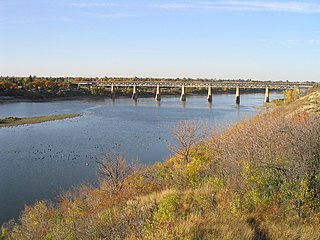
The Saskatchewan River is a major river in Canada, about 550 kilometres (340 mi) long, flowing roughly eastward across Saskatchewan and Manitoba to empty into Lake Winnipeg. Through its tributaries the North Saskatchewan and South Saskatchewan, its watershed encompasses much of the prairie regions of central Canada, stretching westward to the Rocky Mountains in Alberta and northwestern Montana in the United States. It reaches 1,939 kilometres (1,205 mi) to its farthest headwaters on the Bow River, a tributary of the South Saskatchewan in Alberta.

The Churchill River is a major river in Alberta, Saskatchewan and Manitoba, Canada. From the head of the Churchill Lake it is 1,609 kilometres (1,000 mi) long. It was named after John Churchill, 1st Duke of Marlborough and governor of the Hudson's Bay Company from 1685 to 1691.
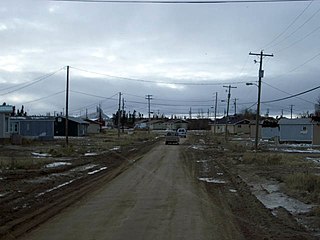
Split Lake is a community in Manitoba on the north shore of Split Lake (Manitoba) on the Nelson River about 150 miles west southwest of the river's mouth at Hudson Bay and is within Split Lake 171, a reserve of the Tataskweyak Cree Nation.
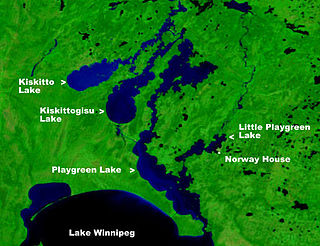
Playgreen Lake is a lake in the province of Manitoba in Canada. The lake covers an area of 657 km2 (254 sq mi) and it is a part of the Nelson River watershed. The lake is the ninth largest lake in the province. It is located along the Nelson River some 10 kilometres (6.2 mi) north from the north end of Lake Winnipeg. It was first mapped by noted British surveyor, map-maker, chief fur trader and explorer Peter Fidler in 1809.
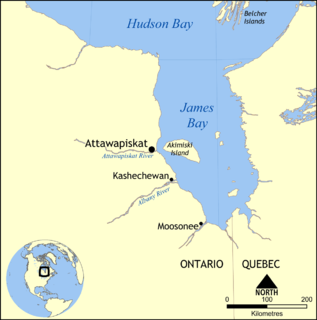
The Attawapiskat River is a river in Kenora District in northwestern Ontario, Canada, that flows east from Attawapiskat Lake to James Bay.

The Bolton River is a river in the Hudson Bay drainage basin in Census Division No. 22 - Thompson-North Central, Northern Region, Manitoba, Canada. It is about 115 kilometres (71 mi) long and begins at Musketasonan Lake, about 20 kilometres (12 mi) south of Molson Lake, at an elevation of 249 metres (817 ft). It flows northeast through Little Bolton Lake at an elevation of 224 metres (735 ft), Rushforth Lake at an elevation of 218 metres (715 ft), Bolton Lake at an elevation of 212 metres (696 ft), where it takes in the right tributary Nikik River, and Kakwusis Lake at an elevation of 208 metres (682 ft). The river continues northeast over the twin Kasukwapiskechewak Rapids, then over the twin Kakwu Rapids, and empties into Aswapiswanan Lake at an elevation of 186 metres (610 ft), about 60 kilometres (37 mi) west southwest of the community of Gods Lake Narrows. The Bolton River's waters eventually flow into Gods Lake, and via the Gods River and the Hayes River into Hudson Bay.

The Mink River is a river in the Hudson Bay drainage basin in Census Division No. 22 - Thompson-North Central, Northern Region, Manitoba, Canada. It is about 14.7 kilometres (9.1 mi) long and begins at Aswapiswanan Lake at an elevation of 186 metres (610 ft). The river takes in one significant tributary, an unnamed river from the Colen Lakes, from the left at 54°29′57″N95°13′06″W before emptying into Touchwood Lake at an elevation of 184 metres (604 ft). The Mink River's waters eventually flow into Gods Lake, and via the Gods River and the Hayes River into Hudson Bay.
Aswapiswanan Lake is a lake in the Hayes River drainage basin in Census Division No. 22 - Thompson-North Central, Northern Region, Manitoba, Canada. The lake is about 22 kilometres (14 mi) long and 2.6 kilometres (1.6 mi) wide and lies at an elevation of 186 metres (610 ft). The primary inflows from west to east are the Hungry River, Porcupine Creek, the Bolton River and the Joint River. The primary outflow is the Mink River. The lake's waters eventually flow into Gods Lake, and via the Gods River and the Hayes River into Hudson Bay.
Musketasonan Lake is a lake in the Hayes River drainage basin in Census Division No. 22 - Thompson-North Central, Northern Region, Manitoba, Canada. The lake is about 4.5 kilometres (2.8 mi) long and 1.6 kilometres (1.0 mi) wide and lies at an elevation of 249 metres (817 ft). It is the source of the Bolton River, whose waters eventually flow into Gods Lake, and via the Gods River and the Hayes River into Hudson Bay.
Touchwood Lake is a lake in the Hayes River drainage basin in Census Division No. 22 - Thompson-North Central, Northern Region, Manitoba, Canada. The lake is about 20.9 kilometres (13.0 mi) long and 4.4 kilometres (2.7 mi) wide and lies at an elevation of 184 metres (604 ft). The primary inflows are the Mink River, Wanless Creek, and the Wapawukaw River, and the primary outflow is a channel to Vermilyea Lake. The lake's waters eventually flow into Gods Lake, and via the Gods River and the Hayes River into Hudson Bay.
Vermilyea Lake is a lake in the Hayes River drainage basin in Census Division No. 22 - Thompson-North Central, Northern Region, Manitoba, Canada. It is shaped like the letter "L" on its side, is about 9.3 kilometres (5.8 mi) long and 8.2 kilometres (5.1 mi) wide, and lies at an elevation of 184 metres (604 ft). The primary inflow is a channel from Touchwood Lake, and the primary outflows are the twin channels of the Wesachewan River to Gods Lake. The lake's waters eventually flow via the Gods River and the Hayes River into Hudson Bay.
Little Bolton Lake is a lake in the Hayes River drainage basin in Census Division No. 22 - Thompson-North Central, Northern Region, Manitoba, Canada. The lake is about 15 kilometres (9.3 mi) long and 4 kilometres (2.5 mi) wide and lies at an elevation of 224 metres (735 ft). The primary inflow and outflow is the Bolton River, whose waters eventually flow into Gods Lake, and via the Gods River and the Hayes River into Hudson Bay.
Bolton Lake is a lake in the Hayes River drainage basin in Census Division No. 22 - Thompson-North Central, Northern Region, Manitoba, Canada. The lake is at an elevation of 212 metres (696 ft); the main body of the lake is about 15 kilometres (9.3 mi) long and 8 kilometres (5.0 mi) wide, but an arm extends a further 11 kilometres (6.8 mi) for a total width of 19 km as well. The primary inflows are the Bolton River from the west and the Nikik River from the south, and the primary outflow is Bolton River, whose waters eventually flow into Gods Lake, and via the Gods River and the Hayes River into Hudson Bay.
Kakwusis Lake is a lake in the Hayes River drainage basin in Census Division No. 22 - Thompson-North Central, Northern Region, Manitoba, Canada. The lake is about 3.6 kilometres (2.2 mi) long and 1.6 kilometres (1.0 mi) wide and lies at an elevation of 208 metres (682 ft). The primary inflow and outflow is the Bolton River, whose waters eventually flow into Gods Lake, and via the Gods River and the Hayes River into Hudson Bay.
Rushforth Lake is a lake in the Hayes River drainage basin in Census Division No. 22 - Thompson-North Central, Northern Region, Manitoba, Canada. The lake is about 11 kilometres (6.8 mi) long and 1.4 kilometres (0.9 mi) wide and lies at an elevation of 218 metres (715 ft). The primary inflow and outflow is the Bolton River, whose waters eventually flow into Gods Lake, and via the Gods River and the Hayes River into Hudson Bay.

The Boyne River is a river in the Hudson Bay drainage basin in the Central Plains and Pembina Valley Regions of Manitoba, Canada.

The Wolf River is a river in census division No. 22 in Manitoba, Canada. It is in the Hudson Bay drainage basin and is a right tributary of the Hayes River.
